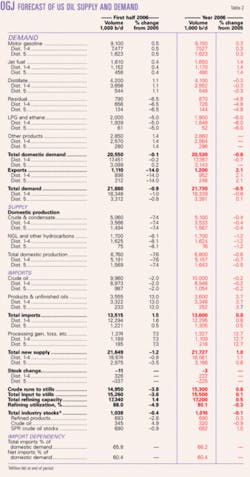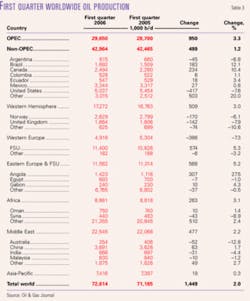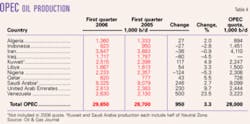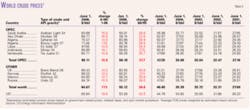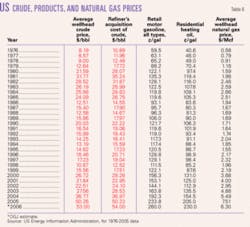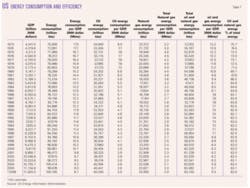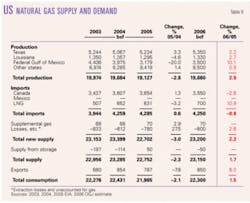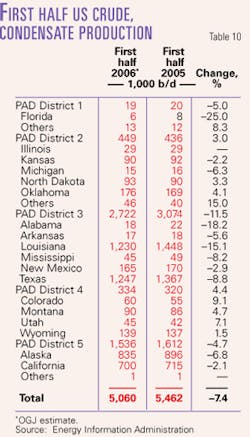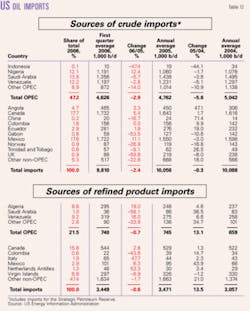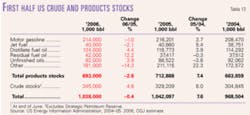US oil demand will be little changed this year, as economic expansion slows and transportation fuel prices remain elevated.
Consumption of all sources of energy in the US will remain near 2005 levels as well. OGJ expects small increases in demand for natural gas, nuclear, and renewable energy sources this year.
Gasoline and jet fuel demand will post small increases in consumption, and US net imports as a percentage of domestic demand will inch up from last year.
Natural production decline rates and another active Atlantic hurricane season stand to offset gains from some large new production facilities in the deepwater Gulf of Mexico this year, so US oil production will be down marginally. Oil product imports will increase nearly 4%, as limited refining capacity in the US remains a bottleneck in the supply chain.
Worldwide oil demand
The International Energy Agency’s most recent estimates place 2006 global oil demand growth at 1.24 million b/d, slightly higher than 2005 growth of 1.1 million b/d.
With total oil product demand estimated to be 84.9 million b/d, IEA said that a booming global economy remains supportive of growth, but high prices are weighing on consumption.
In addition, the Paris-based agency said that weakness in demand in Asian and European countries of the Organization for Economic Cooperation and Development has partly offset recent strength in demand in the US and China.
In fact, despite a weak first quarter, North American oil demand is forecast to increase to 25.62 million b/d this year, up from 25.42 million b/d. Year-on-year, OECD Europe and Pacific demand will each be up only about 10,000 b/d from 2005, IEA said.
IEA reported that Chinese apparent demand-refinery production plus net product imports-grew by an unexpectedly strong 9.6% in April from a year earlier, with gasoline demand up 20% in line with increased vehicle sales. For the year, IEA says Chinese oil demand will increase 380,000 b/d to 6.96 million b/d.
China’s diesel demand surged 11% in April, following first-quarter growth of 4%, spurred by the country’s rapidly expanding economy. In the long-term, China’s recently imposed hikes in gasoline and diesel prices should dampen demand growth and ease pressure on refiners, though.
Elsewhere, oil demand will increase to 6.46 million b/d in the Middle East, a 330,000 b/d climb. And in Latin America, IEA says that demand for oil products will grow 120,000 b/d to 5.2 million b/d this year.
Global production
Non-OPEC production of crude, condensate, NGL, and other liquids will grow 1.1 million b/d this year, according to IEA. Among these producers, the former Soviet Union and Africa will lead output growth.
Compared with 2005, oil production in non-OPEC African countries will move up to 4.1 million b/d from 3.7 million b/d. And IEA sees FSU output growing to 12.1 million b/d from 11.6 million b/d.
But Energy Security Analysis Inc. of Boston reported last month that one of the most important changes in the Atlantic Basin oil markets is the largely ignored gradual decline in Russian oil exports.
“While the Russian oil export data have to be taken with a grain of salt, the preliminary numbers from the energy ministry show a nearly 40,000 b/d year-on-year decline in Russian non-CIS oil exports via the Transneft system in the first 5 months of this year,” says Yulia Woodruff, Russian oil analyst at ESAI. While the absolute number is small-about 1% of the country’s exports outside of CIS-ESAI believes the trend is likely to continue.
Since the beginning of the year, Russian refinery runs have increased by 300,000 b/d, while crude production has only grown by 230,000 b/d. ESAI does not believe that Russia’s crude production in the next 6 months will outpace the climb in throughput.
North Sea, Canada
Production growth in other areas, such as the North Sea, is constrained by the availability of equipment and people needed to put planned projects into practice in a timely manner.
“High oil prices coupled with a collective desire by governments for increased activity will see continued success for the North Sea in the second half of 2006,” says Hans Middelton, investment manager for 3i, a London-based venture capital company.
“Shortage of rigs, combined with aging infrastructure, is likely to cause delays in development plans and lead to a higher cost base. Furthermore, the shortage of skilled labor will remain a challenge for the E&P companies,” Middleton said.
And recently, UK Chancellor of the Exchequer Gordon Brown doubled the supplementary tax on oil company profits to 20% (OGJ, Feb 27, 2006, p. 29).
“Gordon Brown’s recent tax raid on oil will have affected the economics of certain proposed plans, but more generally risks challenging the confidence of oil companies when it came to continuing to choose to invest in the North Sea, rather than elsewhere,” said Robin Clarkson, a partner in the energy law unit of Scottish law firm Paull & Williamsons.
Oil production in Canada, particularly extraction of that country’s oil sands deposits, is constrained by a need for workers and equipment, too. Still, Canadian oil production is projected to increase to 4.6 million b/d in 2015, from 2.5 million b/d last year, according to the Canadian Association of Petroleum Producers (CAPP).
CAPP forecasts that oil sands production, which now exceeds 1 million b/d, will reach 3.5 million b/d by 2015, and 4 million b/d by 2020, accounting for more than 80% of Canadian production.
Although the lifespan of conventional producing wells is being extended as higher oil prices make marginal wells economic, conventional oil production in Canada has been in decline since the 1990s.
OPEC output
The official output ceiling for members of the Organization of Petroleum Exporting Countries (excluding Iraq) has been unchanged at 28 million b/d since July 2005. Since this ceiling was set, IEA estimates show that the group’s crude output has exceeded that total, however.
Average 2005 crude oil output by all 11 OPEC members was 29.76 million b/d. Iraqi crude production last year averaged 1.8 million b/d. And IEA estimates that total OPEC crude production averaged 29.87 million b/d in the first quarter of this year.
OGJ forecasts that OPEC crude output will average just less than 30 million b/d for the remainder of this year. Coupled with the group’s NGL supply, this would put average 2006 worldwide oil supply at 85.5 million b/d.
OPEC’s limited, but slowly growing spare production capacity is one of the many factors believed to be holding oil prices near $70/bbl.
Oil prices
OGJ forecasts that US refiners will pay $53/bbl on average for crude this year. The US refiners’ acquisition cost of crude soared last year to $50.23/bbl from $36.98/bbl a year earlier.
In this year’s first half, the price of crude on the New York Mercantile Exchange was elevated by a host of geopolitical factors, including continuing unrest in Iraq.
Also among the factors supporting oil prices are potential risks to oil supplies from Iran amid disagreement on its nuclear intentions and Nigeria due to rebel attacks.
On May 2 the near-month contract for crude oil on the NYMEX closed at an all-time nominal-dollar high of $74.61/bbl.
On June 1 various world crude prices hovered around $70/bbl. Nigerian Bonny Light 37° traded for $71.48/bbl and Arabian Light 34° crude was $63.68/bbl.
A weakened US dollar, though, has cut into many exporting nations’ profits.
Adam E. Sieminski, chief energy economist at Deutsche Bank AG, last month said, “Recent weakness in the US dollar is adding to OPEC’s desire to keep oil prices high. With oil traded almost exclusively in US dollars, OPEC’s spending power has been eroded.”
Sieminski said, “We doubt that oil exporters will find a substitute for US dollar pricing, and that implies continuing pressure to maintain high dollar-denominated oil prices.”
Oil product prices
Retail gasoline prices, which have climbed over the past 3 years, will average $2.60/gal this year.
Gasoline prices have been supported since the destruction to facilities on the US Gulf Coast caused by Hurricanes Katrina and Rita in 2005. Boosting prices this year are not only the price of crude and demand for the product, but also tight supplies amid this year’s switch to summer-grade fuel and the increased use of ethanol as a blending component.
The US average retail price for regular gasoline increased to $2.906/gal as of June 12, up $0.776 from a year earlier, EIA reported.
In 2005, the average US retail gasoline price, for all types of gasoline, was up 22% to $2.338/gal.
With production and imports plentiful, supplies of distillate have been adequate. Still, the retail price of heating oil will climb to average $2.30/gal this year.
Last year, the price of heating oil gained 32% to average $2.05/gal.
Natural gas prices
The wellhead price of natural gas in the US this year will average $6.30/Mcf. This will be a 16% decline from the average 2005 price.
Based on heating-degree days, the US winter this year was warmer than normal, led by an especially mild January. In this year’s first quarter, average US gas consumption was 2,106 bcf, down from 2,330 bcf for the comparable 2005 quarter.
On NYMEX in the first half of this year, gas futures eased off their fourth-quarter 2005 highs.
The price for gas delivered in January closed on Dec. 13, 2005, at $15.378/MMbtu. On the last day of trading for the June 2006 contract, the closing price of gas on the NYMEX was $5.925/MMbtu.
From that point, the price turned around and began to inch up in anticipation of a hot summer and increased need for cooling. Prices also were somewhat bumped up by the start of the Atlantic hurricane season.
US economy, demand
There have been concerns that not only elevated oil prices but also higher interest rates and inflation will curtail US economic growth this year.
The Federal Reserve Board began raising the federal funds rate in 2004. A series of 25 basis point increases has put the interest rate at 5%, up from 1% before the hikes began. At presstime last week, it was widely expected that the Fed would again raise the rate by 25 basis points at its June 29 meeting.
OGJ forecasts that the US economy will grow this year, with gross domestic product moving up 3.3%/year.
With this growth OGJ forecasts a small increase in 2006 energy demand. Total US energy consumption will be 100.2 quadrillion btu (quads), up from 99.9 quads last year.
In 2005, US energy use declined from the all-time high of 100.4 quads the prior year.
With the small increase in energy demand this year, energy use efficiency will improve. Energy use will decline to 8.7 quads/$ of GDP from 9 quads/$ of GDP last year.
Energy by source
Consumption of natural gas, nuclear, and renewable energy sources will grow this year, but oil and coal demand will stagnate in the US.
High prices for oil and coal relative to natural gas will translate into greater gas demand.
OGJ forecasts that US gas consumption will grow 1.5% this year to 22.95 quads. Electric power generation will drive this growth.
Oil prices will modestly dampen consumption for petroleum products this year. Oil demand will total 40.2 quads, down from 40.4 quads in 2005. Transportation fuel demand will remain strong, but gasoline and diesel prices will encourage some conservation.
Combined, oil and gas will meet 63% of all US energy demand this year.
Coal demand will be little changed at 22.8 quads. The mild weather in January and February suppressed demand for coal early this year.
The most recent data available from EIA show that residential, electric power, and commercial coal consumption during the first few months of this year declined from a year earlier. Coal consumption by industrial users was up for the same period, though.
Nuclear energy demand will grow 1% this year to 8.2 quads.
Growth is constrained by the number of operable nuclear energy units. But electricity generation from nuclear plants peaked in 2004 at 788.5 million kw-hr.
Last year, nuclear energy’s share of total US electricity net generation declined to 19.3% from 19.9% in 2004. The 104 operable nuclear units in the US last year operated at 89.4% of capacity.
Renewable energy sources will fulfill 6% of US energy needs this year. By far, the majority of this will be from hydroelectric power and from biomass, which includes wood, waste, and alcohol fuels, such as ethanol.
Wind still supplies only a small amount of energy to electric power generation, but it is growing. In this year’s first quarter, the amount of electric power generated from wind was about double that of last year.
US natural gas
US natural gas demand will increase 1.5% this year. Hot summer weather will spur demand, which lagged during this year’s first quarter with a mild heating season.
Last year, gas consumption declined 2%. The amount of gas delivered to electric power plants increased 6% year-on-year for 2006, EIA figures show. Meanwhile, gas volumes delivered to industrial consumers declined 9% last year. In the first quarter of this year, gas consumption by residential, commercial, industrial, and electric power customers was down from the same quarter a year earlier.
OGJ expects gas production in the US to rebound this year, up nearly 3% after last year’s 2.8% decline.
Although hurricane season in the Gulf of Mexico will be another active one this year, it will be less destructive to production facilities and pipelines than was last year’s tropical storm season. In addition, shipments of LNG to the US will be less affected by adverse weather.
Last month, shut-in gas production in the gulf was about 9% of normal pre-Hurricane Katrina and Rita output, according to US Minerals Management Service. On June 19, MMS reported that in the past month there had been substantial improvement in the production numbers.
Total US imports of gas will decline to 4.25 tcf this year from 4.29 tcf. While LNG imports will climb, imports from Canada will dip, and no gas will be imported from Mexico in 2006.
OGJ forecasts that the US will import 700 bcf of LNG this year, up from 631 bcf last year.
In 2004, LNG imports totaled 652 bcf. Last year’s decline was led by a substantial reduction in imports from Trinidad and Tobago, Algeria, and Australia but was mostly offset by a gain of 72.5 bcf of imports from Egypt.
US gas exports will increase 8% to 850 bcf. This will result in an annual draw of 50 bcf from gas in storage.
US oil demand
Demand for oil products in the US will be little changed this year, up less than 1%.
Last year, US oil consumption declined 0.4%, according to EIA. Although the economy was strong, demand for transportation fuels failed to grow, partly held in check by prices.
Jet fuel consumption will lead the oil products in growth this year, while demand for motor gasoline and distillate will be nearly unchanged, and demand for residual fuel oil and other products declines.
Although it leads oil products demand in growth this year, jet fuel demand will be up only 1.4% to 1.65 million b/d. Last year demand was unchanged annually, up in the first 4 months of 2005 but down year-on-year from 2004 for most of the second half of 2005.
Motor gasoline consumption will increase just 0.3% to 9.15 million b/d this year. Pump prices continue to be a drag on discretionary driving, as they were last year. In 2005, gasoline consumption grew only 0.2%.
US demand for residual fuel oil will slide to 870,000 b/d, down from 913,000 b/d a year ago. When natural gas has a cost advantage over resid, it is generally preferred for use in power generation and by industrial consumers with fuel-switching capability.
Total US distillate consumption will be 4.1 million b/d, nearly unchanged from last year. API reported that in the first 4 months of this year, disposition of high-sulfur distillate fuel oil, which includes heating oil, was up 4% from the corresponding year-earlier period.
Ultralow-sulfur diesel, with 15 ppm sulfur, is due in the first retail locations on Sept. 1. This phase-in from diesel having as much as 500 ppm sulfur is expected to provide air quality benefits, but prices will increase.
US demand for LPG and ethane will decline this year by almost 6% to average 1.9 million b/d. Last year US production and disposition of LPG declined more than 5%. Production at natural gas processing plants was down as high gas prices dragged down NGL output.
Consumption of all other petroleum products in the US this year will be unchanged at 2.86 million b/d. These products include pentanes plus, oxygenates, unfinished oils, and gasoline blending components.
US oil supply
Total US liquids production will decline to 6.8 million b/d from 6.83 million b/d last year. Crude and condensate production will average 5.1 million b/d. This year’s slight decline comes in spite of some major offshore developments peaking this year in the Gulf of Mexico.
Kerr-McGee Corp.’s Constitution and Ticonderoga fields started up in the first quarter of this year with liquids production set to peak at 70,000 b/d (OGJ, June 12, 2006, p. 41). Also, BP PLC’s Thunder Horse production will come on stream this year and will peak at 250,000 b/d of liquids production.
During the first half of this year, oil production declines in Alaska, Louisiana, and Texas offset gains in Colorado, Utah, Montana, and Oklahoma. OGJ estimates that first half US oil production fell 7.4% from a year ago to average 5.06 million b/d.
In 2005, Alaskan oil production declined to average 864,000 b/d. This compares to average output of 908,000 b/d in 2004.
NGL and liquefied refinery gas production will average 1.7 million b/d this year, down 0.5%. US production of NGLs and other liquids declined last year to average 1.7 million b/d from 1.8 million b/d the prior year.
Imports
US oil imports will increase this year. Product imports will grow, but crude imports will decline slightly.
OGJ forecasts that 2006 crude imports will average 10 million b/d. Imports of petroleum products will average 3.6 million b/d, up from 3.47 million b/d last year.
In 2005, the source of the most US crude oil imports was Canada. The US imported on average 1.643 million b/d of crude from Canada last year.
The second largest source for crude imports last year was Mexico, followed by Saudi Arabia, Venezuela, and Nigeria. Total US crude imports from OPEC member countries in 2005 averaged 4.76 million b/d. Oil product imports from OPEC member countries averaged 746,000 b/d.
But Canada was the leading individual country source for US petroleum product imports last year. The US imported an average of 529,000 b/d of products from Canada. The next largest sources of products imported by the US were the US Virgin Islands, Venezuela, and Algeria.
Inventories
For the first half of 2006, crude stocks were above year-earlier levels.
EIA figures show that at the end of January, crude oil stocks held at refineries, pipelines, lease tanks, and in transit to refineries totaled 323.8 million bbl. This is up from 288.6 million bbl at the end of January 2005.
At mid-June, crude stocks remained well-above year-ago inventories. As of June 16, crude stocks were 347.1 million bbl vs. 330.9 million bbl a year earlier.
These figures exclude crude held in the Strategic Petroleum Reserve, which stood at 688.6 million bbl on June 16.
Though they were mostly up through the first quarter, at midyear product inventories generally were off a bit from the same time last year. At the end of the first half, stocks of gasoline and jet fuel were down marginally from a year earlier. At the same time, distillate and resid stocks were a bit higher than at the end of June 2005.
OGJ expects inventories to close this year nearly unchanged from the end of 2005. Crude stocks will be slightly lower at 320 million bbl, while product stocks will be 690 million bbl. Crude oil in the SPR will total 692 million bbl, up from 685 million bbl at the end of 2005.
Refining
Static US refining capacity is the bottleneck in the fuels market, holding a floor under prices. And no substantial capacity additions will be operational in the next few years.
Refinery activity this year will be up slightly from last year’s averages, which were deeply affected by hurricane damage.
OGJ forecasts that inputs to refineries and operable capacity will inch up this year, but that average utilization will decline a bit from 2005.
For the first 5 months of this year, the American Petroleum Institute reported that US refinery utilization was 87.7%. For the same 2005 period, utilization was 91.8%.
By the end of May, all of the refineries that had been closed due to Hurricanes Katrina and Rita were reopened, and all but two had resumed normal operations, API said.
OGJ forecasts that for 2006, average US refinery utilization will be 90.1%, down from 90.4% last year. This assumes total inputs to refineries of 15.5 million b/d with operable capacity of 17.2 million b/d.
Refining margins will remain high as long as no major crude capacity additions are brought on stream.
The US West Coast cash refining margin averaged $21.03/bbl last year, according to Muse, Stancil & Co. This compares with a 2004 average of $12.45/bbl. For the first 5 months of this year, that margin averaged $29.77/bbl.
Peaking in September 2005 at $28.06/bbl, the US Gulf Coast refining margin last year averaged $12.90/bbl. That average for the year is up 99% from 2004, and up from $3.23/bbl in 2003.
Refiners’ acquisition prices for crude have escalated as well, and will gain 8% to average $54/bbl this year.

